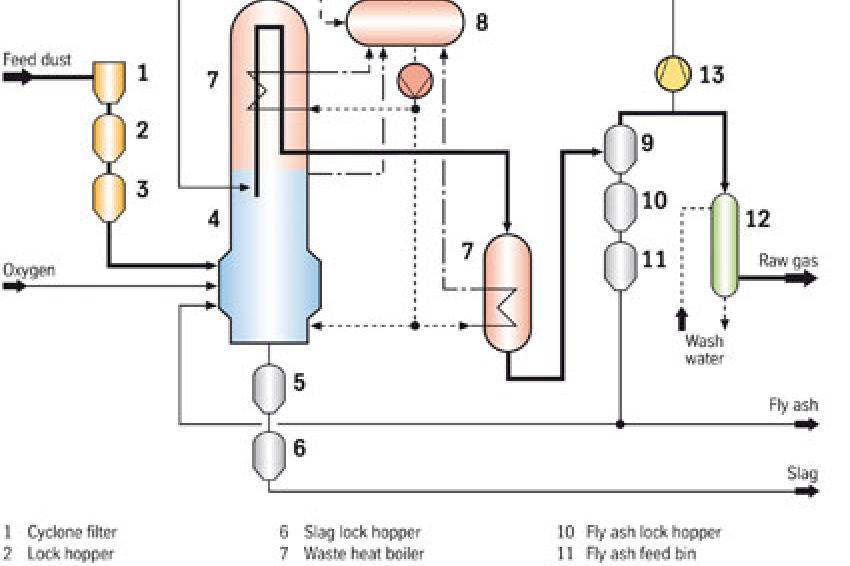Tried And Tested
Uhde’s Prenflo Gasification Process Stands the Test of Time
Power - The world's largest IGCC (integrated gasification combined-cycle) power plant has now been generating electric power from a coal/petcoke mixture for more than 11 years. Uhde's Prenflo gasification process is at the heart of the Puertollano plant in Spain.
Elcogas's 300MWe (net) IGCC plant in Puertollano, Spain uses a 50/50 mixture of high-ash run-of-mine Puertollano coal and high-sulfur petcoke from the Repsol refinery in Puertollano. In March 1998, clean gas from the Prenflo gasification unit was used for the first time in the gas turbine to generate power. The Prenflo gasification unit is based on the world's first process to apply the entrained-flow principle: the Koppers-Totzek process developed by Koppers, now part of Uhde, in the early 1940s.
The IGCC System
The block diagram (fig.1) shows the main units of the highly integrated IGCC system at the Puertollano plant, which consists of three blocks:
- The air separation unit;
- The gasification island with the feed preparation unit, the Prenflo gasification unit, the desulfurization unit and Claus unit for sulfur recovery;
- The power block, comprising the gas and steam turbines and the heat recovery steam generator.
The total air for the air separation unit is supplied by the gas turbine compressor. At new IGCC plants only a portion of the air for the air separation unit can be extracted from the gas turbine. The nitrogen from the air separation unit which is not needed for the processes is added to the clean gas before combustion in the gas turbine. This results in low NOx values in the flue gas without additional catalytic treatment. The average NOx value for 2007 was 145.4 mg/m³n at 6 vol. % oxygen (in 2006 = 135.9 mg/m³n). The EU Directive from 2001 specifies a limit of 500 mg/m³n and Elcogas's plant permit was 200 mg/m³n.
Furthermore, very good SO2 values are achieved after desulfurization: i.e. 27.5 mg SO2/m³n flue gas at 6 vol. % oxygen was the average value for 2007. The level specified in the EU Directive from 2001 as well as in Elcogas's plant permit is 200 mg/m³n.
Desulfurization of the raw gas from the Prenflo gasification unit is achieved by means of the MDEA (methyl diethanol amine) process combined with a COS hydrolysis system. The special feature is the closed-cycle gas treatment, i.e. the tail gas from the Claus unit is hydrogenated and then recycled to the MDEA unit. Therefore, no sulfur-containing gases enter the atmosphere.
After each shutdown the plant must be started up using natural gas such as at a normal combined cycle (CC) plant, before the air separation unit and then later the gasification unit can be started. The fuel cost for the generation of one MW electric power is more than three times higher than the fuel cost using coal/petcoke during normal operation. With the coal/petcoke mixture the Puertollano plant achieves a gross efficiency of 47.1 % and a net efficiency of 42.2 %. The elevation of the plant as well as the high amounts of ash and sulfur in the fuel is a disadvantage for IGCC technology. With the new type of modern gas turbines, the power output of IGCC plants can be increased to more than 400MWe and higher efficiencies can be achieved. One Prenflo gasifier supplies the gas required for one gas turbine.
Prenflo Gasification
The Uhde/Koppers-developed Prenflo process with Steam Generation (PSG) was selected for gasification of the special feedstock: a mixture of coal and petcoke. The feedstock composition and an analysis of the raw gas produced are shown in the table (fig. 2). The process with dry dust feed achieves the highest efficiencies in IGCCs.
Oxygen is the gasification agent. In Puertollano the oxygen purity is only 85 vol. %. High-pressure (126 bar) and medium-pressure (35 bar) steam is generated in the gasification unit and mainly used in the power block. The process flow diagram (fig. 3) shows the main components of the gasification unit: the fuel dust feed system, the gasifier with slag removal, the waste heat boiler system, the candle filters for dry raw gas dedusting with the lock hopper system, and the wet dedusting system. Problems have been encountered with candle filters where the ceramic candles are supported at the bottom. These can be solved if the candles are suspended instead.
At the moment the fuel contains an addition of around 5 % biomass material. Ultimately, up to 10 % of olive waste, i.e. stones and skins, will be ground and dried and then gasified together with the main fuel.
Outlook
Electric power generation from coal or other solid fuels, e.g. petcoke or biomass, will play an important role in the near future. This is even truer for countries like China, India, and the U.S. It is therefore necessary to use the best available technology to achieve maximum efficiencies and the best environmental data. If CO2 capture (CCS - carbon capture and storage technology) becomes mandatory, the prospects for IGCC are excellent, even if power generation is approximately 8-10 percentage points less efficient than normally.
For IGCC plants with CO2 capture, the new Prenflo process with Direct Quench (PDQ) is the technology of choice. The saturated raw gas can be sent directly to the CO shift conversion unit for gas treatment. The PDQ version is also ideally suited for the production of hydrogen, SNG (substitute natural gas), chemicals (ammonia, methanol) and gasoline.
The new Chinese trends favor IGCC technology with polygeneration, i.e. power generation and the production of hydrogen, chemicals, etc. A forecast from the IEA (International Energy Agency) in 2007 for the years 2020 - 2030 shows hydrogen production costs from large IGCC plants with CCS in third place, directly behind natural gas-based steam reforming plants with and without CCS.
Contact
ThyssenKrupp Uhde
Friedrich-Uhde-Straße 15
44141 Dortmund
Germany
+49 231 547 0
+49 231 547 3032








